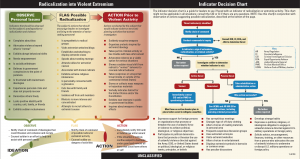 |
| Army’s “Radicalization into Violent Extremism” |
Madison Ruppert, Contributor
Activist Post
A newly released document, originally published by the U.S. Army’s Asymmetric Warfare Group in 2011, reveals that the Army has guidelines just as insane as other government agencies that consider ordinary bodily movements and just about everything else an indicator of potential terrorist activity.
At this point, it is almost comical how many things can be considered an indicator of terrorism including bumper stickers, boisterous groups of Middle Eastern males and even educational or trade school information.
The nearly endless list of indicators just got longer with documents (PDF courtesy of Danger Room) uncovered by Danger Room which reveal that the U.S. military actually considers having “peculiar discussions” a sign that you might suddenly murder your colleagues along with “believ[ing] in government conspiracies to the point of paranoia.”
Other warning signs include recently changing your “choices in entertainment,” “complain[ing] about bias,” being “socially withdrawn” and being frustrated with “mainstream ideologies.”
The Army claims that “Risk Factors for Radicalization” include “youth” and “social networks,” both of which are so common that one might conclude that the vast majority of young people are potential terrorists.
Of course, some of the warning signs they include are somewhat legitimate, although still hardly conclusive, including “inquir[ing] about weapons of mass effects,” “attempt[ing] to recruit others to extremist causes,” and “stor[ing] or collect[ing] mass weapons or hazardous materials.”
However, none of these are necessarily criminal and some of the “Actions conducted by the subject that would indicate violent or terroristic planning activities that warrant investigation” are outright laughable.
One of the more insane indicators includes “suddenly acquir[ing] weapons,” which could mean that anyone who goes out and buys a gun could be seen as possibly planning terroristic activities.
Others are “organiz[ing] protests inspired by extremist ideology,” “establish[ing] website/blog to display extremist views” and “visit[ing] extremist websites/blogs.”
The glaring issue here is that these documents don’t specifically describe what “extremist” views are, which means just about anyone can be included under this troublingly large umbrella.
The Army’s “’indicators’ of radicalization are vague enough to include both benign behaviors that lots of people safely exhibit and, on the other end of the spectrum, signs that someone is so obviously a terrorist they shouldn’t need to be pointed out. It’s hard to tell if the group is being politically correct or euphemistic,” writes Spencer Ackerman for Danger Room.
Another document from 2011 published by the Asymmetric Warfare Group out of Forge Meade, Maryland entitled, “Insider Threats in Partnering Environments,” attempts to identify some signs a member of a “partner” force might suddenly kill their U.S. colleagues.
 According to the Army, potential “insider threats” from Afghan troops someone who “appears frustrated with partnered nations,” reads “questionable reading materials,” or who has “strange habits,” all of which are disturbingly ambiguous.
According to the Army, potential “insider threats” from Afghan troops someone who “appears frustrated with partnered nations,” reads “questionable reading materials,” or who has “strange habits,” all of which are disturbingly ambiguous.
Ackerman rightly points out that it is incredibly difficult for an American soldier with little to no knowledge of the surrounding culture who doesn’t speak Pashto or Dari to properly identify “strange habits” of people who likely seem strange in most respects already.
While the Asymmetric Warfare Group didn’t claim that they had identified every single factor leading to so-called insider threats, they did claim that they painted an accurate picture of both the signs that someone could potentially be radicalized.
Thankfully, they caution against using their assessments as “checklists,” but this doesn’t outright condemn the practice nor does it stop people from using it as if it was a one-size-fits-all terrorist identification tool.
That being said, when one of the “Actions conducted by the subject that would indicate violent or terroristic planning activities that warrant investigation” includes “tak[ing] suspicious or unreported travel (inside or outside the United States),” there is legitimate reason for concern.
Others include “emotional vulnerability,” “personal connection to a grievance” and “conflict at work or at home, which, considered together with the previously outlined potential terrorism indicators means that there is likely not a single risk-free person in the world anymore.
Let’s not forget, the Asymmetric Warfare Group calls on people to “notify the chain of command” about all the suspicious behavior outlined above, even something as laughable as “chang[ing] type of off-duty clothing.”
They point out that a “single reportable indicator is enough to report,” meaning that soldiers should likely be reporting every single person they work with.
While the concern is wholly legitimate given the more than 50 U.S. and allied troops murdered by Afghans this year alone, the approach the military is taking is hardly going to encourage a friendly native population seeing as now U.S. soldiers are trained to see just about everything as an indicator of potential terroristic intentions.
Please support our work and help us start to pay contributors by doing your shopping through our Amazon link or check out some must-have products at our store.
This article first appeared at End the Lie.
linkwithin_text=’Related Articles:’


Be the first to comment on "Army documents: complaining about bias, believing in government conspiracies are terrorism indicators"